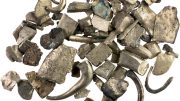
Artistic rendering of a large collision on the early Earth. Scientists from Yale and SwRI have presented a new theory on why gold and platinum are found closer to Earth’s surface, focusing on a unique “transient” mantle region that captures and distributes these metals. Credit: SwRI/Marchi
New research offers a theory on how gold, platinum, and other precious metals found their way to shallow pockets within Earth’s mantle.
Scientists at Yale and the Southwest Research Institute (SwRI) say they’ve hit the jackpot with some valuable new information about the story of gold.
It’s a story that begins with violent collisions of large objects in space, continues in a half-melted region of Earth’s mantle, and ends with precious metals finding an unlikely resting spot much closer to the planet’s surface than scientists would have predicted.
New Insights on Precious Metals
Jun Korenaga, a professor of Earth and planetary sciences in Yale’s Faculty of Arts and Sciences, and Simone Marchi, a researcher at SwRI in Boulder, Colorado, provide details in a study in the journal Proceedings of the National Academy of Sciences.
Their new theory provides possible answers to lingering questions about the way gold, platinum, and other precious metals found their way to shallow pockets within Earth’s mantle rather than deep in the planet’s core. More broadly, the new theory offers insights into planet formation throughout the universe.
“Our research is a good example of making an unexpected discovery after re-examining conventional wisdom,” Korenaga said.
Historical Context and Challenges
Recent research from scientists around the world has established that precious metals such as gold and platinum came to Earth billions of years ago after the early proto-Earth collided with large, moon-sized bodies in space, which left behind deposits of materials that were folded into what is today’s Earth.
But that absorption process has remained something of a mystery.
Aside from being valued for their scarcity, aesthetic beauty, and use in high-tech products, gold and platinum are what is known as highly “siderophile” elements. They are drawn to the element iron to such a degree that they would be expected to collect almost entirely in Earth’s metallic core — either by merging directly with the metal core on impact or by sinking quickly from the mantle into the core.
By this logic, they should not have collected at or near the Earth’s surface. Yet they did.
A Groundbreaking Theory
“Working with Simone, who is an expert on impact dynamics, I was able to come up with a novel solution to this conundrum,” Korenaga said.
Korenaga and Marchi’s theory centers around a thin, “transient” region of the mantle, where the shallow part of the mantle melts and the deeper part remains solid. The researchers found that this region has peculiar dynamic properties that can efficiently trap falling metallic components and slowly deliver them to the rest of the mantle.
Their theory posits that this delivery is still ongoing, with the remnants of the transient region appearing as “large low-shear-velocity provinces” — well-known geophysical anomalies in the deep mantle.
“This transient region almost always forms when a big impactor hits the early Earth, making our theory quite robust,” Marchi said.
The researchers said the new theory not only explains previously enigmatic aspects of Earth’s geochemical and geophysical evolution, but it also highlights the wide range of time scales involved in Earth’s formation.
“One of the remarkable things we found was that the dynamics of the transient mantle region take place in a very short amount of time — about a day — yet its influence on subsequent Earth evolution has lasted a few billion years,” Korenaga said.
For more on this research, see Are Moon-Sized Impacts the Secret Behind Gold & Platinum in Earth’s Mantle?
Reference: “Vestiges of impact-driven three-phase mixing in the chemistry and structure of Earth’s mantle” by Jun Korenaga and Simone Marchi, 9 October 2023, Proceedings of the National Academy of Sciences.
DOI: 10.1073/pnas.2309181120
Funding for the research came from NASA and the National Science Foundation.









Strangely, there is no mention of the role of plate tectonics in recycling oceanic crustal rocks or continental rocks subducted from the surface. While rocks enriched in gold are often found on the margins of serpentinized mantle material, there is usually a negative correlation between gold and Platinum Group Minerals almost exclusively found in ultramafic rocks. Also, what doesn’t get mentioned is that there is plentiful evidence that gold chlorides are circulated in hydrothermal fluids in brittle, near-surface rocks along with abundant milky quartz. I think that computer models make it too easy to ‘confirm’ preconceived hypotheses.
If gold was introduced to earth from space then how is it that gold is one of the elements found inside tbe human body?
Iron (Al-Ĥadīd):25 – Indeed, We have sent Our messengers with clear proofs and We have sent down with them the Book and the scales (of justice) so that people can carry out justice. And We created iron in which there is great strength and various benefits for humans, (so that they use the iron) and so that Allah knows who helps His (religion) and His messengers even though Allah does not see them. Indeed, Allah is All-Powerful, All-Mighty.